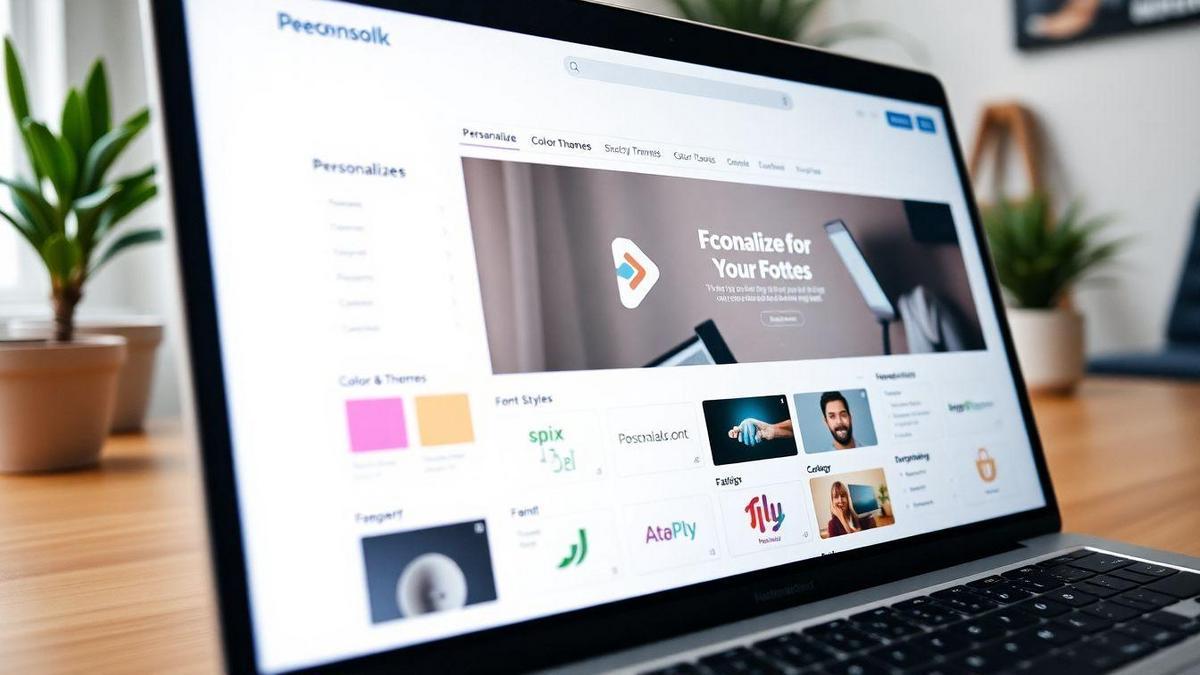What to Consider Before Choosing a Website Builder in 2025? Whether you’re starting a new project or revamping an old site, the right site builder can make all the difference. In this article, you’ll explore key features, customization options, costs, and tools that will help you create a website that truly reflects your brand. You’ll also discover how user reviews and future trends can guide your choice. Let’s dive in and find the perfect site builder for your needs!

Key Features to Look for in a Site Builder in 2025
Essential Tools and Resources for Your Site
When you’re diving into the world of site builders in 2025, there are essential tools and resources you should keep an eye out for. These features will help you create a site that looks good and functions well. Here’s a quick rundown of what you should consider:
| Feature | Importance |
|---|---|
| Drag-and-Drop Editor | Makes it easy to design without coding skills. |
| Responsive Templates | Ensures your site looks great on all devices. |
| SEO Tools | Helps your site rank better on search engines. |
| E-commerce Capabilities | Essential if you plan to sell products online. |
| Analytics Integration | Allows you to track your site’s performance. |
These tools are like the Swiss Army knife for your website. They give you everything you need to build, manage, and grow your online presence.
Importance of Customization Options
Customization options are another key factor to think about. You want a site builder that lets you put your personal stamp on your website. Why is this so important? Because your site should reflect your brand’s personality. When visitors land on your page, they should feel like they’ve stepped into your unique world.
How Customization Can Enhance Your Brand
Customizing your site can truly elevate your brand. Here’s how:
- Brand Identity: Use colors, fonts, and images that match your brand.
- User Experience: Tailor navigation to make it easy for visitors to find what they need.
- Engagement: Create interactive features that keep users coming back.
When your site feels personal and engaging, it can turn casual visitors into loyal customers. Remember, a well-customized site tells your story in a way that resonates with your audience.
Understanding the Cost of Site Builders in 2025
Comparing Pricing Plans for Different Builders
When you’re looking for a site builder, it can feel like a maze. Prices can vary widely, and each builder has its own set of features. Here’s a quick comparison to help you make sense of it all:
| Site Builder | Basic Plan | Premium Plan | Features Included |
|---|---|---|---|
| Wix | $14/month | $39/month | Custom domain, templates, SEO tools |
| Squarespace | $16/month | $54/month | E-commerce, analytics, templates |
| Weebly | $6/month | $26/month | E-commerce, marketing tools |
| WordPress.com | $4/month | $25/month | Custom domain, themes, plugins |
As you can see, the cost can really add up depending on what you need. If you want to build a simple blog, a basic plan might work. But if you’re aiming for an online store, a premium plan could be worth the investment.
Hidden Costs You Should Be Aware Of
Now, let’s talk about those sneaky hidden costs. Sometimes, the price you see isn’t the price you pay. Here are a few things to keep in mind:
- Transaction Fees: Some builders take a cut of your sales.
- Add-Ons: Features like extra storage or premium templates can cost extra.
- Domain Registration: Some builders charge for a custom domain.
- Support Fees: Premium support might come at a cost.
These extras can add up quickly, so keep your eyes peeled. Always read the fine print before signing up.
Budgeting for Your Site Builder Needs
Creating a budget for your site builder is key. Start by listing out what you want your site to do. Here’s a simple way to break it down:
- Monthly Fees: Determine the basic plan you need.
- Add-On Features: Consider any extra tools you might want.
- Domain Costs: Factor in the cost of your domain.
- Marketing Expenses: Think about any advertising or SEO tools.
By planning ahead, you can avoid surprises and keep your site running smoothly.

Ease of Use: Why It Matters in 2025
User-Friendly Interfaces for Beginners
In 2025, user-friendly interfaces are more important than ever. You want to build a website without pulling your hair out, right? A site builder with a simple layout can make all the difference. Look for platforms that offer drag-and-drop features. This means you can easily move things around without needing to know any coding.
Imagine being able to create your dream website just by clicking and dragging. That’s the kind of ease you should expect. Some popular site builders even offer templates that are ready to go. You just fill in your information, and voilà! Your website is up and running.
Learning Curve: What to Expect
When you pick a site builder, be ready for a bit of a learning curve. But don’t worry! Most builders are designed with beginners in mind. You might need some time to get used to the tools, but it’s not rocket science.
Here’s a quick table of what you might experience:
| Site Builder | Learning Curve | Time to Get Started |
|---|---|---|
| Wix | Low | 1-2 hours |
| Squarespace | Medium | 2-4 hours |
| WordPress | High | 4-6 hours |
Tips for Navigating Your Chosen Site Builder
To make your journey smoother, here are a few tips:
- Start with Tutorials: Most site builders have helpful tutorials. Watch them! They can save you a lot of time.
- Experiment: Don’t be afraid to click around. Play with different features to see what works best for you.
- Join Communities: Online forums and groups can be a goldmine. You can ask questions and learn from others’ experiences.
By following these tips, you’ll be well on your way to creating a fantastic website.
SEO Features to Consider in a Site Builder
Importance of SEO for Your Website
When you’re building a website, SEO (Search Engine Optimization) is like the magic key that opens the door to more visitors. Without it, your site might be like a hidden gem in a dark alley—great, but no one can find it! SEO helps your site show up in search results, making it easier for people to discover what you have to offer. In today’s digital landscape, having a site that’s optimized for search engines can mean the difference between success and being lost in the crowd.
Key SEO Tools to Look For
When choosing a site builder, you want to look for certain SEO tools that can help you climb the search engine ranks. Here’s a quick table of must-have features:
| SEO Tool | Description |
|---|---|
| Keyword Analysis | Helps you find the right words to attract visitors. |
| Meta Tags | Lets you customize titles and descriptions for better visibility. |
| Mobile Optimization | Ensures your site looks good on phones and tablets. |
| Analytics | Tracks how many visitors you have and what they do on your site. |
| SSL Certificate | Secures your site, which search engines love. |
How SEO Can Drive Traffic to Your Site
Think of SEO as your website’s roadmap. It guides people to your content and helps them find exactly what they’re looking for. By using the right keywords, crafting engaging content, and optimizing your site’s structure, you can attract more visitors. Imagine writing a blog about your favorite recipes. If you use keywords like “easy dessert recipes” or “quick dinner ideas,” you’ll likely pull in readers who are searching for those terms.
The more traffic you get, the better your chances of turning visitors into loyal customers or followers. It’s like throwing a party—if you send out invites (SEO), more people will show up!

Compatibility with Other Tools and Platforms
Integrating Your Site Builder with Other Software
When you’re choosing a site builder, think about how it will work with other tools you already use. You want everything to play nice together. For example, if you use email marketing software, make sure your site builder can connect with it easily. This way, you can collect emails and send newsletters without any hassle.
Here are some tools you might want to integrate:
- Social Media Platforms: Link your site to Facebook, Instagram, and Twitter.
- Analytics Tools: Use Google Analytics to track your visitors.
- Payment Processors: If you’re selling online, ensure it works with PayPal or Stripe.
Importance of E-commerce Compatibility
If you plan to sell products online, compatibility with e-commerce tools is a must. Your site builder should support features like shopping carts, product pages, and secure payment options. This is crucial for a smooth shopping experience for your customers.
Here’s a quick table to help you understand what to look for:
| Feature | Why It Matters |
|---|---|
| Shopping Cart | Allows customers to buy multiple items. |
| Secure Payments | Builds trust with your customers. |
| Inventory Management | Helps you keep track of stock levels. |
Ensuring Smooth Operations Across Platforms
You want your site to work well on all devices—desktops, tablets, and smartphones. A good site builder will make sure your site looks great no matter where it’s viewed.
Also, check if it can handle updates easily. You don’t want to be stuck with an outdated site. Regular updates keep your site running smoothly and securely.
The Role of Technical Support in Site Builders
Types of Support Offered by Site Builders
When you’re diving into the world of site builders, you’ll find that technical support is like having a trusty guide by your side. It helps you tackle any bumps in the road. Here are some common types of support you might encounter:
- Live Chat: Instant help from a support agent.
- Email Support: Send your questions and get responses in a few hours.
- Phone Support: Talk directly to someone who can help you.
- Knowledge Base: A collection of articles and FAQs to answer common questions.
- Community Forums: Connect with other users to share tips and tricks.
How to Access Help When You Need It
Getting help should be as easy as pie! Most site builders have their support options right in the dashboard. Here’s how you can get assistance:
- Check the Help Section: Look for a “Help” or “Support” tab.
- Use Live Chat: If available, click on the chat icon for instant support.
- Email Your Query: Fill out a form or send an email for detailed questions.
- Browse the Knowledge Base: Search for answers to common issues.
- Join Community Forums: Post your question and see what others have to say.
Evaluating Support Quality Before You Choose
Before you pick a site builder, take a moment to evaluate their support quality. Here’s a simple table to help you compare:
| Feature | Site Builder A | Site Builder B | Site Builder C |
|---|---|---|---|
| Live Chat | Yes | No | Yes |
| Email Response Time | 1 hour | 24 hours | 2 hours |
| Knowledge Base Size | Large | Medium | Small |
| Community Forum | Active | Inactive | Active |
When you’re checking out different options, think about what matters most to you. Fast responses? A community to lean on? Make sure you find a builder that meets your needs for support.

Personalization Options to Enhance Your Site
Templates vs. Custom Designs
When you’re building your site, you’ll often face a choice between templates and custom designs. Templates are like a pre-made cake; they come with a set design that you can decorate a bit. They’re quick and easy. But if you want something that truly reflects your style, a custom design is the way to go. Think of it as baking your cake from scratch, where you control every ingredient.
| Feature | Templates | Custom Designs |
|---|---|---|
| Time to Set Up | Quick and easy | Takes longer to create |
| Cost | Generally cheaper | Usually more expensive |
| Flexibility | Limited customization options | Fully tailored to your needs |
| Maintenance | Easier to update | May need ongoing support |
Importance of Branding Through Personalization
Your brand is your identity online. Personalizing your site helps you stand out. It’s like wearing a signature outfit that reflects who you are. When you make your site feel like you, visitors are more likely to connect with it. This connection can lead to more trust and, ultimately, more business.
Branding elements you might consider personalizing include:
- Colors: Choose colors that resonate with your brand.
- Fonts: Select fonts that match your style.
- Images: Use images that tell your story.
Finding the Right Balance for Your Site
Finding the right balance between a template and a custom design is key. You want your site to be functional but also visually appealing. Here are a few tips to help you strike that balance:
- Start with a Template: If you’re new, a template can be a great starting point.
- Add Personal Touches: Customize colors, fonts, and images to make it yours.
- Seek Feedback: Ask friends or colleagues what they think about your site’s look.
By blending the ease of templates with your personal flair, you’ll create a site that feels just right.
User Reviews and Recommendations for Site Builders
Where to Find Reliable Reviews
When you’re on the hunt for a site builder, finding honest reviews is key. You want to hear from real users, right? Here are some great places to look:
- Review Websites: Sites like Trustpilot or G2 have user feedback that can guide your decision.
- Forums and Communities: Check out places like Reddit or Facebook groups where people share their experiences.
- YouTube: Many creators post reviews and tutorials. Watching these can give you a clear picture of how a site builder works.
How User Feedback Can Guide Your Choice
User feedback is like a treasure map. It points you in the right direction. Here’s how it can help you:
- Identify Strengths and Weaknesses: Users often highlight what they love and what bugs them about a site builder.
- Compare Options: By reading reviews, you can see how different builders stack up against each other.
- Get Real-Life Examples: Users share stories about their experiences, which can help you envision how a site builder might fit your needs.
Learning from Others’ Experiences with Site Builders
Let’s face it: learning from others can save you time and headaches. Here’s what to keep in mind:
- Look for Common Themes: If multiple users mention a similar issue, it’s worth taking note.
- Consider the Context: What works for a small business might not work for an online store. Think about your specific needs.
- Be Open-Minded: Sometimes, a builder that seems perfect might not be the best fit after all.
| Site Builder | Pros | Cons |
|---|---|---|
| Builder A | Easy to use, great templates | Limited features |
| Builder B | Lots of customization | Steeper learning curve |
| Builder C | Affordable plans | Customer support issues |

Future Trends in Site Builders for 2025
Emerging Technologies Shaping Site Building
As we look ahead to 2025, technology is set to transform how you build your website. Imagine using artificial intelligence (AI) to create a site that feels like it was crafted just for you. AI can help suggest designs, optimize content, and even adjust layouts based on user behavior.
Another exciting trend is voice search optimization. With smart speakers and voice assistants becoming more popular, your site builder will likely include tools to ensure your content is voice-search friendly. This means you can reach more visitors who prefer speaking to typing.
Key Technologies to Watch:
| Technology | Impact on Site Building |
|---|---|
| Artificial Intelligence | Personalized design and content recommendations |
| Voice Search Optimization | Enhanced accessibility and user experience |
| Augmented Reality | Interactive elements that engage visitors |
| Progressive Web Apps | Better performance across devices |
Predictions for Site Builder Features in the Coming Years
Get ready for some exciting features in site builders! In the next few years, you can expect:
- Drag-and-drop interfaces that are even more intuitive.
- Template libraries that offer a variety of styles and layouts to fit your needs.
- E-commerce tools that make it easier to sell online, including integrated payment options.
- SEO tools that guide you through optimizing your site without needing to be a tech whiz.
These features will not only make building a site easier but also more fun. You’ll feel empowered to create something that truly represents you or your brand.
Staying Ahead of the Curve with Your Site Builder
To keep your website fresh and relevant, it’s important to stay updated with trends. Here are some tips to help you stay ahead:
- Follow industry blogs: Websites like Smashing Magazine and SitePoint provide insights into the latest trends in web design.
- Experiment with new tools: Don’t hesitate to try out new features your site builder offers. They might just make your life easier!
- Engage with online communities: Join forums or social media groups where you can share experiences and learn from others.
By staying informed and proactive, you’ll be ready to adapt your site as new technologies emerge.
Frequently asked questions
What features should you look for in a site builder in 2025?
Look for easy customization options, mobile responsiveness, and good SEO tools. Make sure it has templates that fit your style.
How important is customer support when choosing a site builder?
Very important! You want quick help if things go wrong. Check if they offer live chat or 24/7 support.
Can I change my site builder later?
Yes, you can switch, but it might be tricky. Always back up your content first. Think about how hard it would be to move your site!
What is the cost of using a site builder in 2025?
Prices vary a lot. Some are free, while others charge monthly. Look at your budget and what features you need before deciding.
Why is it important to know “What to Consider Before Choosing a Website Builder in 2025”?
Knowing helps you make a smart choice. You don’t want to waste time or money on the wrong builder. Do your research!

Marina is a passionate web designer who loves creating fluid and beautiful digital experiences. She works with WordPress, Elementor, and Webflow to create fast, functional, and visually stunning websites. At ReviewWebmaster.com, she writes about tools, design trends, and practical tutorials for creators of all levels.
Types of articles she writes:
“WordPress vs. Webflow: Which is Best for Your Project?”
“How to Create a Visually Stunning Website Without Hope”
“Top Landing Page Design Trends for 2025”
Why it works:
She brings a creative, accessible, and beginner-friendly perspective to the blog, perfectly complementing Lucas’s more technical and data-driven approach.
